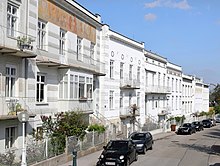Art Nouveau row houses in Brunn am Gebirge
The Art Nouveau row houses in Brunn am Gebirge are considered to be the most uniform ensemble in the style of the Vienna Secession . The houses are in Franz-Keim-Gasse (house numbers 4–22) in Brunn am Gebirge in the Mödling district of Lower Austria .
history
Starting in 1902, Sepp Hubatsch built an ensemble of ten two-family houses on the outskirts of Brunn am Gebirge. Vineyards in the vicinity of his house in Maria Enzersdorf were available to him as building ground. Two of the buildings remained in his possession.
description
All buildings are roughly equally wide and vertically structured by four window axes. Despite the upward slope of the alley, they appear equally high due to the different heights of the basement floors. They were designed for two families each. Each house was designed individually within this uniform floor plan. The facades are decorated with vegetable ornaments and geometric motifs.
In the first construction phase, between 1902 and 1903, houses No. 4 to 8 were built in the ornamental style of the Vienna Secession; they are still without balconies. An angel frieze, a statue of the Virgin Mary at house number 8 and inscription friezes under the eaves with sayings on all three houses express a religious program.
While the vegetable ornaments were more pronounced in the first phase, the second construction phase, which was implemented from 1906, was dominated by geometric structuring elements such as plaster strips and square grids.
The motif of the angel frieze is repeated on houses number 4 and 14, as these buildings bordered the ensemble between 1908 and 1912. The motif on house no.8 is also attached symmetrically to house no.18, which was built in 1912.
On the houses built later there are balconies typical of Art Nouveau in various shapes. At number 16, the only one with a colored frieze, the ground floor balcony was closed with windows leading to a veranda. House number 20 has a closed bay window instead of a balcony on the ground floor, which carries a balcony with an Art Nouveau grille.
A plaque on house number 12 reminds of the house where the writer Franz Keim lived and died , who gave the street its name.
The architect lived in the complex himself and gradually sold the houses. He owned house no.14 until 1932 and he spent the last years of his life until 1935 in house no.16, which his widow lived in until 1936 after his death.
The ensemble was restored in 1979.
literature
- Roland L. Schachl: An Art Nouveau Ensemble in: Old and Modern Art Sept.-Oct. 1971, p. 25f
- Marco Pozzetto: Otto Wagner's School 1894-1912 , Vienna-Munich 1980
- W. Kitlitschka : Historicism & Art Nouveau in Lower Austria , 1984
- Austrian Society for the Preservation of Monuments and Townscapes: Country House and Villa in Lower Austria 1840-1914 , Vienna-Cologne-Graz 1982
Web links
- Entry on Franz-Keim-Gasse in Brunn in the database of the state's memory for the history of the state of Lower Austria ( Museum Niederösterreich )
Individual evidence
- ↑ Magazine for building, architecture and design " Gestalten ", published by the Lower Austrian State Government, No. 145 09/2014, p. 16
Coordinates: 48 ° 6 ′ 6.1 ″ N , 16 ° 16 ′ 45.4 ″ E












